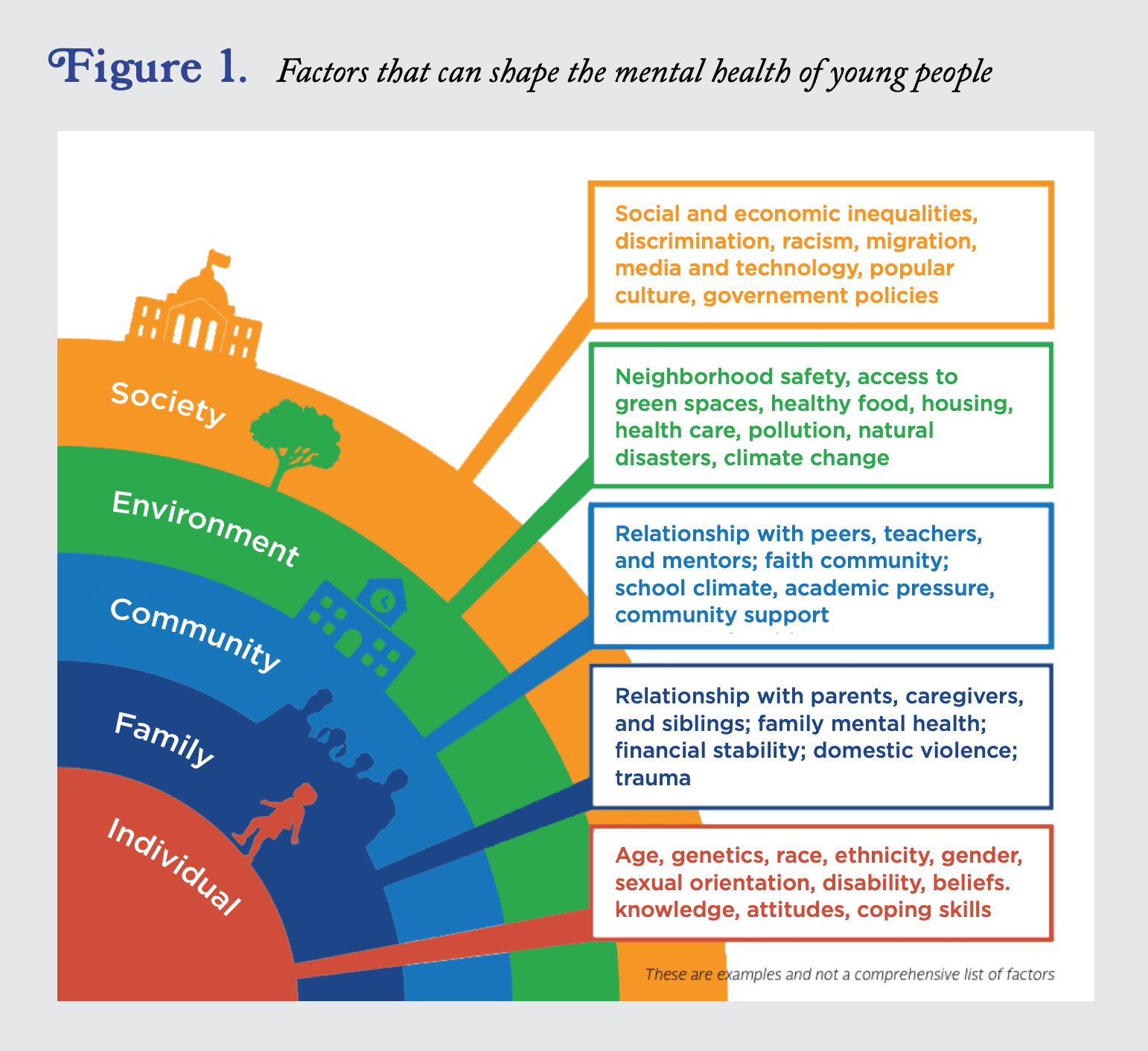3/6 “Part 1 - CHALLENGES — THE STATE OF OUR YOUTH.”
Part 1 reviews America’s youth mental health including self-harm, addiction, anxiety, violent crime, and bullying. Among the multiple and complex causes behind these issues, this section asks whether a significant root cause could be from early childhood and, specifically, attachment.
MENTAL HEALTH
Suicide
As recently as December 2021, the Surgeon General published an Advisory to bring the nation’s immediate awareness and action to bear upon the state of mental health among America’s young people.
Nearly 3 in 5 (57 percent) U.S. teen girls felt persistently sad or hopeless in 2021. Feelings of sadness and hopelessness had increased by 40 percent in the period between 2009 and 2019, a 36 percent increase in those contemplating suicide, and a 57 percent increase in suicide rates among 10–24-year-olds in the period between 2007 and 2018.
It is estimated that 6,600 young people aged 10 to 24 killed themselves in 2020. This makes the suicide rate in the U.S. the highest among wealthy countries, and the second leading cause of death in this age group after unintentional injuries. In all, 49.5 percent of adolescents in America has had a mental health disorder at some point in their lives.
Self-harm
Self-harm and suicidal ideation have increased notably too among America’s youth. There has been a COVID effect in this. Forbes reported how insurance claims for intentional self-harm as a percentage of all medical claim reports in the 13 to 18 age group increased 99.8 percent during the time frame April 2019 to April 2020. For overdoses a 119 percent increase, generalized anxiety 94 percent, and major depressive disorders 84 percent. In the Northeast of the United States claims for intentional self- harm in this period leapt by 333.9 percent.
Such an increase, however, isn’t just about COVID. A 2009-2015 study indicates that among hospital admissions of girls ages 10-14, rates of self-injury had increased by almost 19 percent.16 A 2018 study showed that 18 percent of 64,000 teens sampled had self-harmed. The main reason given for young people performing self-harm was to “regulate their emotions”. Research shows that teenagers who self-harm are more likely to have mental health problems in adulthood too.
Other studies suggest a deterioration in the ability of young adults to handle stress and self-regulate. The proportion of 18- and 19-year-old first year students at the University of California Los Angeles (UCLA) who “felt overwhelmed by all they had to do” has increased steadily since the Higher Education Research Institute have carried out the survey: in 1985, 18 percent; 2000, 28 percent; and by 2016, nearly 41 percent.
Addiction
Running alongside this rise in mental health deterioration, is a rise in drug use and polysubstance abuse. Drug use among 8th graders went up 61 percent between 2016 and 2020,20 with overdose deaths among 15- to 24-year-olds increasing from 1,240 in 1999 to 4,777 in 2019.
Rushed legalization of marijuana, and labels like “medicinal” or “recreational,” have perhaps not helped with substance misuse among adolescents. 12.78 percent of all 12- to 17-year-olds report using marijuana in the last year,21 despite research linking its use among adolescents to serious mental illness such as schizophrenia—research which has been widely available for some years now.
The Centers for Disease Control and Prevention report that 15 percent of high school students have “used select illicit or injection drugs (i.e. cocaine, inhalants, heroin, methamphetamines, hallucinogens, or ecstasy).” Drug use is associated with sexual risk behavior, experience of violence, and mental health and suicide risks.
While it appears that young people drink less than their adult counterparts, when adolescents do drink, they drink more. In 2021, 3.2 million youth ages 12 to 20 reported binge drinking at least once in the past month.
Polysubstance use in late childhood can continue on into early adulthood, during important emotional, social, psychological and career milestones. The concern, therefore, is that a growth of drug use in childhood may not be an experimental phase but can persist.
This may explain why Substance Use Disorder (SUD) has been increasing in the United States for decades among both adults and adolescents.
Anxiety
American children have been experiencing a rise in anxiety in recent years too. The number of children with anxiety increased by 20 percent from 2007 to 2012, when 11.6 percent of children reported anxiety.
One 2020 study showed that anxiety had increased from 5.12 percent in 2008 to 6.68 percent in 2018 among adult Americans with the most notable increase from 7.97 percent to 14.66 percent among respondents 18-25 years old.
A JAMA Pediatrics report published in 2022 found that between 2016 and 2020, there were significant increases in children diagnosed with anxiety (up by 20 percent) and depression (up by 27 percent).
In summary, anxiety and depression are becoming increasingly prevalent among 18-30-year- olds in the U.S., with both disorders increasing by 63 percent from 2005 to 2017.
Violent crime
Violent juvenile crime peaked in 1994,30 and then declined. Yet there has been a stark reversal of this trend since 2020. In 2020, homicides by juveniles acting alone rose by 30 percent, while those committed by multiple juveniles increased by 66 percent. The number of homicides committed by children under 14 was the highest in twenty years.
Youth homicides and nonfatal physical assault-related injuries are not only a horrific loss of life: they are estimated to cost $18.2 billion a year in medical and lost productivity costs.
Among young people ages 10-24, homicide is the leading cause of death for African Americans, the second leading cause of death for Hispanics, and the third leading cause of death for American Indians and Alaska Natives.
Bullying
Rates of bullying have remained about the same on average across all age groups, or gone down, since records began in 2005—28 percent compared to 20.2 percent today. Yet statistics and studies on bullying rates vary. What has increased is cyber bullying, which accounts for 15 percent of bullying for 12–18-year-olds. It also appears that bullying rates overall are higher for younger children. For 9–12-year-olds, 49.8 percent experienced bullying, and 14.5 percent bullying online.
Fear of assault may explain why among 9th-12th graders, 7.8 percent report carrying a weapon on school property. There are 1,642 young people treated in emergency rooms for physical assault across the United States every day on average.
Meanwhile, almost 1 in 3 teenagers in the U.S. is a victim of teen dating violence, which involves physical, sexual, emotional, or verbal abuse from a dating partner.
The U.S. Surgeon General is right to draw urgent attention to the state of mental health among American youth. As he states, the factors that can help shape the mental health of young people include the individual, their family, their community, their neighborhood, wider culture and government policies.
However, this report considers the role of early childhood and attachment as a significant and overlooked factor. The interlocking layers of support, from family to society, must work to assist secure attachment. Presently, too many obstacles exist for families hoping to achieve secure attachment—with serious consequences for both individuals and society.
SOURCE: The U.S. Surgeon General’s Advisory, 2021.



